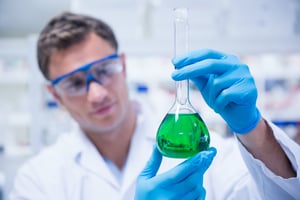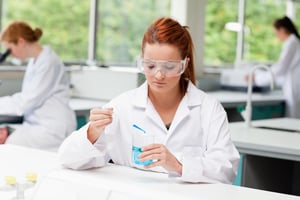With more than half a million workers employed in laboratories across the United States, it’s critical for facilities to take lab safety seriously.
Laboratory employees are exposed to many potential hazards, from dangerous chemicals to physical hazards and toxic fumes.
Yet it’s often unclear exactly how many accidents or exposures occur in labs every day. A survey published in the journal, Nature, found that 25 to 38% of academic lab personnel who had been involved in an accident or injury in the lab never reported it to a supervisor or investigator.
Often, it’s the most severe lab incidents that we hear about, yet accidents have the potential to occur and do occur every day. Ensuring your laboratory is operating at top safety levels means putting into place lab safety rules that become an important part of your workplace culture. Here are some examples of some important lab safety rules and guidelines that should be part of your lab safety protocols.
Know …
What you’re working with. Knowledge is everything when it comes to lab safety. If you don’t know the substance or chemical you are working with, you won’t know how to treat an injury and minimize any further hazards.
chemical you are working with, you won’t know how to treat an injury and minimize any further hazards.
The locations of laboratory safety equipment. This includes safety showers, eyewash stations and fire extinguishers, as well as first aid kits.
Emergency exit routes. Make sure these are properly and clearly labeled, including on evacuation maps.
Where important lists and information are located. This includes chemical inventory lists, material safety data sheets (MSDS or SDS), department laboratory safety manuals and standard operating procedures (SOPs).
Perform Safety Checks On …
Your laboratory fume hood. Fume hoods are common in laboratories and should undergo safety checks before every use. Your fume hood safety checklist should include:
- Ensure the hood sash is opened to the proper height to provide the proper level of protection.
- Check the air gauge to ensure the airflow is within the required range.
- Make sure the exhaust fan is working so that hazardous chemical fumes can escape.
- Check the baffles in the exhaust fan since these keep airflow uniform.
- Double check there are no spark sources nearby that can cause a fire or explosion.
- Examine the air filters to ensure they are not clogged.
Wear …
The proper protection. Depending on your laboratory and what applications are being performed, this may vary. It’s important that your lab technicians know what personal protective equipment is required. PPE may include:
- Clean room garments like lab coats, coveralls and full body suits
- Eye protection like goggles and face shields
- Gloves
- Protective hearing devices
- Hard hats
- Respirators
- Safety shoes and protectors
- Surgical face masks
Fabric that protects against ESD. Spark sources can be a major concern in laboratories. If ESD, or electrostatic discharge, is a concern in your lab, you will want to ensure your technicians wear PPE or clothing that is made of static dissipative fabric.
Fabric that is resistant to chemicals. Another concern is the impact of chemicals on fabric. For example, polypropylene allows moisture to evaporate more quickly than traditional clothing. It is also resistant to many acids and alkalis that may be used in a laboratory setting.
Clothing that is NOT made of synthetic fibers if working with flammable liquids. Synthetic fibers tend to melt and stick to exposed skin when exposed to flames.
Never …
Leave containers of chemicals open and unattended.
Consume beverages and food where hazardous chemicals are used or stored.
Leave long hair down or loose clothing exposed in areas where entanglement could be an issue.
Pour chemicals down drains. Chemicals no longer needed should be properly disposed of according to chemical waste disposal regulations.
Store chemicals inside a fume hood. Instead, they should be stored in the proper laboratory cabinets.
Always …
Have your employee training procedures updated. As a lab manager, you should ensure all employees and students who work in your lab receive the proper initial training for safety lab procedures. However, all technicians should receive routine, updated training as a refresher or to inform them of new equipment, procedures or chemicals being used in the lab.
who work in your lab receive the proper initial training for safety lab procedures. However, all technicians should receive routine, updated training as a refresher or to inform them of new equipment, procedures or chemicals being used in the lab.
Ensure all chemicals are labeled properly. Labels should include a product identifier, the chemical concentration and a pictogram that represents the potential hazards.
Attend laboratory safety training before beginning an assignment or project.
Read all procedures and safety information associated with your experiment before beginning.
Notify a supervisor of any accidents or any unsafe conditions.
Report damaged electrical equipment and other types of lab equipment to a supervisor.
Practice good personal hygiene by washing your hands before entering and leaving the work area, as well as after handling potentially hazardous materials.
Have a plan in place if an accident occurs. This plan should include:
- Responding to the accident first
- Investigating the cause
- Preparing a root cause analysis that identifies the primary source of the problem
- Fixing the problem
- Testing new procedures
Know helpful resources. There are many resources available through organizations like the Occupational Safety and Health Administration (OSHA), the UC Center for Laboratory Safety and the ACS Center for Lab Safety. Many of these organizations offer training, safety videos, safety tools and examples of standard operation procedures you can use to make your lab the safest possible for your employees.


